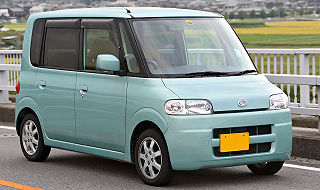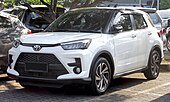
Daihatsu Motor Co., Ltd., commonly known as Daihatsu, is a Japanese automobile manufacturer and one of the oldest surviving Japanese internal combustion engine manufacturers. The company's headquarters are located in Ikeda, Osaka Prefecture.

The Daihatsu Move is a kei car/city car manufactured by the Japanese automaker Daihatsu since August 1995. The Move is Daihatsu's response to the similarly designed Suzuki Wagon R that was introduced two years earlier in 1993. The Move is built upon the chassis of the Mira but with a taller body.

The Daihatsu Terios is a mini SUV produced by the Japanese automobile manufacturer Daihatsu since 1997 as the successor to the F300 series Rocky. It was initially offered in both short- and long-wheelbase configurations before the former stopped production in 2016 to be replaced by the A200 series Rocky crossover in 2019. The long-wheelbase variant is available mainly for the Indonesian market with three-row seating options. A smaller kei car model called the Terios Kid/Lucia was also available for the first-generation model.

The Toyota Noah is a minivan with two rear sliding doors built by Toyota and sold mainly in Asian countries. It is positioned below the Alphard, and above the Sienta. The Noah was also positioned below the Estima until the latter was discontinued in 2019.

The Toyota KR engine family is a straight-3 piston engine, designed by Daihatsu, a subsidiary of Toyota. The 1KR series uses aluminium engine blocks and chain driven DOHC cylinder heads. It uses multi-point fuel injection, and has 4 valves per cylinder. Some versions have VVT-i variable valve timing. The engine is exceptionally light: 69 kg (152 lb) with all ancillaries. This is due to the nature of the applications and weight of city cars.

The Daihatsu Hijet is a cab over microvan and kei truck produced and sold by the Japanese automaker Daihatsu since 1960. Despite the similarities between the Hijet name and Toyota's naming scheme for its trucks and vans, the name "Hijet" has been in use for Daihatsu's kei trucks and microvans since 1960, over two decades before Toyota took control. "Hijet", when transliterated into Japanese, is very similar to "Midget", one of Daihatsu's other mini-trucks. According to Daihatsu, the name "Hijet" was created to imply that the vehicle offers higher performance than the Midget. The Hijet competes in Japan with the Honda Acty, Mitsubishi Minicab, Nissan Clipper, Subaru Sambar and Suzuki Carry.

The Toyota Vios is a nameplate used for subcompact cars produced by the Japanese manufacturer Toyota, primarily for markets in Southeast Asia, China and Taiwan since 2002. Slotted below the compact Corolla, the Vios serves as the replacement to the Tercel, which filled the subcompact or B-segment sedan class in the region. It is also successor to the entry-level variants of the E110 series Corolla in some markets such as the Philippines and Vietnam.

The Daihatsu Tanto is a kei car manufactured by the Japanese carmaker Daihatsu. It was introduced at the 2003 Tokyo Motor Show as a vehicle based on the Move's "tall" body style, and followed by the Tanto Custom in July 2005.

The Daihatsu Gran Max is a series of light commercial vehicles produced and sold by the Japanese automaker Daihatsu since late 2007. It is also rebadged and marketed by Toyota as the Toyota LiteAce and Toyota TownAce since 2008, and by Mazda in Japan as the Mazda Bongo since 2020.

The automotive industry in Japan is one of the most prominent and largest industries in the world. Japan has been in the top three of the countries with the most cars manufactured since the 1960s, surpassing Germany. The automotive industry in Japan rapidly increased from the 1970s to the 1990s and in the 1980s and 1990s, overtook the U.S. as the production leader with up to 13 million cars per year manufactured and significant exports. After massive ramp-up by China in the 2000s and fluctuating U.S. output, Japan is currently the third largest automotive producer in the world with an annual production of 9.9 million automobiles in 2012. Japanese investments helped grow the auto industry in many countries throughout the last few decades.

The Daihatsu Ayla is a city car designed by Daihatsu and manufactured by Astra Daihatsu Motor in Indonesia since 2013, primarily developed for emerging markets. The Ayla has also been sold by Toyota as the Toyota Agya in Indonesia, South Africa, Tunisia and Americas, and the Toyota Wigo in the Philippines, Sri Lanka, Brunei and Vietnam through an OEM agreement. The car is also slightly reengineered and manufactured in Malaysia by Perodua as the Perodua Axia.
Toyota Motor East Japan is a manufacturing subsidiary of the Toyota group based in Japan. It was founded in July 2012 by the merger of Central Motors, Kanto Auto Works and Toyota Motors Tohoku.

The Perodua Axia is a city car produced by Malaysian automobile manufacturer Perodua. It was launched on 15 September 2014 as the successor to the Viva. The car takes over the title of being the most affordable car in Malaysia from the Viva, and the best-selling car in Malaysia for three consecutive years, between 2015 until 2017. The Axia is the first model to debut from Perodua's all-new second factory in Rawang, Selangor. As of mid-2023, the Axia reached 600,000 units sold since the launch of its first generation in 2014.

The Toyota C-HR is a subcompact crossover SUV manufactured by Japanese automaker Toyota since 2016. The development of the car began in 2013, led by Toyota chief engineer Hiroyuki Koba. The C-HR is based on the same TNGA-C (GA-C) platform as the E210 series Corolla, and positioned between the Corolla Cross and Yaris Cross in size.

The Daihatsu Cast is a kei car built by the Japanese manufacturer Daihatsu since 2015. It comes in three variations designated, "Style", "Activa" and "Sport". Each one can be equipped with either front- or four-wheel drive configuration.

The Daihatsu Mira e:S is a kei car manufactured by the Japanese automaker Daihatsu as the successor to the original Mira. It was previewed by the "e:S" concept car at the 2009 Tokyo Motor Show. The car was introduced to the Japanese market in September 2011. It was also sold by Toyota as the Toyota Pixis Epoch, which was released on 10 May 2012 and by Subaru as the Subaru Pleo Plus, which was released on 21 December 2012.

The Toyota Yaris Cross is a nameplate used by the Japanese automaker Toyota for two vehicles in the subcompact crossover SUV category (B-segment). The nameplate first appeared for the crossover SUV counterpart of the XP210 model Yaris based on the Toyota New Global Architecture, which went on sale in August 2020 in Japan and in 2021 in Europe with the model code XP210.

The A200/A250 seriesDaihatsu Rocky is a subcompact crossover SUV manufactured by Daihatsu. It was unveiled at the 46th Tokyo Motor Show on 23 October 2019 under the "New Compact SUV" name. It replaced the Be‣go in the Japanese market and went on sale on 5 November 2019. The Rocky is also rebadged and sold under Toyota and Subaru brands as the Toyota Raize and Subaru Rex respectively.

The Toyota bZ4X, also marketed in Japan, US, Canada, Europe, and China as the Subaru Solterra, is a battery electric compact crossover SUV manufactured by Toyota. The vehicle debuted in April 2021 as the "bZ4X Concept". It is the first vehicle to be based on the e-TNGA platform co-developed by Toyota and Subaru, and the brand's first model to be part of their Toyota bZ series of zero-emissions vehicles.




































